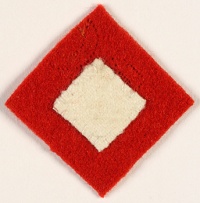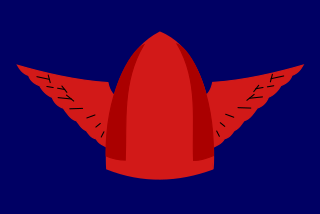
The Guards Armoured Division was an armoured division of the British Army during the Second World War. The division was created in the United Kingdom on 17 June 1941 during World War II from elements of the Guards units, the Grenadier Guards, Coldstream Guards, Scots Guards, Irish Guards, Welsh Guards, and the Household Cavalry.

The 1st Division, formerly known as the 1st Armoured Division, is a division of the British Army. It has recently returned home from being stationed in Germany. Originally formed in November 1937 as the Mobile Division, it saw extensive service during the Second World War and was disbanded afterwards; reconstituted in 1976, it remains in service. It should not be confused with the 1st Infantry Division.

The 11th Armoured Division was an armoured division of the British Army which was created in March 1941 during the Second World War. The division was formed in response to the unanticipated success of the German panzer divisions. The 11th Armoured was responsible for several major victories in the Battle of Normandy from in the summer of 1944, shortly after the D-Day landings of 6 June 1944, and it participated in the rapid advance across France, Belgium, and the Netherlands and, later, the Rhine crossing in March 1945, and later invaded Germany. It was disbanded in January 1946 and reformed towards the end of 1950. In 1956, it was converted into the 4th Infantry Division.

The 6th Armoured Division was an armoured division of the British Army, created in September 1940 during the Second World War. In October 1940, armoured regiments within the Division, such as the 2nd Lothian and Border Horse, were supplied with Matilda MkI.I tanks, then in May 1942 Crusader MkII tanks, in August 1942 Valentine Mk.V tanks and finally in October Crusader MKIIIs. In North Africa tankers were finally put on an almost equal footing to their Panzer counterparts when the M4A2 Sherman medium tank was added to their inventory by March 1943. In November/December 1942 The division participated in the Operation Torch assault landings in Bone, closest to the Axis Forces in all the Torch landings that stretched from Morocco to the Tunisian border. In November 1942 they saw their first action as part of V Corps of the British First Army, First Allied Army in the Tunisia Campaign. In March 1943, around the same time when most of the units had been supplied with American M4A2 Shermans, the Sixth Division came under IX Corp. After Tunisia, the Division participated in the Italian Campaign as part of the British Eighth Army and ended the war in Austria, again under the command of V Corps.

The 8th Armoured Division was an armoured division of the British Army during the Second World War. It was deployed to Egypt in June 1942 but never operated as a complete formation and was disbanded in January the following year.

The 9th Armoured Division was an armoured division of the British Army, raised during the Second World War. It never saw active service during the war as a complete division.

The 10th Armoured Division was an armoured formation of division-size of the British Army, raised during World War II and was active from 1941–1944 and after the war from 1956–1957. It was formed from the 1st Cavalry Division, a 1st Line Yeomanry unit of the Territorial Army (TA) which had previously been serving in Palestine. The division was converted from cavalry to armour and redesignated from 1 August 1941.

The 42nd Armoured Division was an armoured division of the British Army raised during the Second World War.
The 1st Armoured Brigade, raised as the 1st Light Armoured, later the 1st Armoured Brigade Group, was an armoured formation of the British Army.
3rd Regiment Royal Horse Artillery is a regiment of the Royal Horse Artillery in the British Army. They are currently based at Albemarle Barracks, Northumberland, England.
The Second Battle of El Alamein order of battle is a listing of the significant formations that were involved in the Second Battle of El Alamein during the Western Desert Campaign of the Second World War, 23 October – 4 November 1942.

The 7th Support Group was a supporting formation within the British 7th Armoured Division, active during the Second World War's Western Desert Campaign.
The 8th Support Group was a brigade-sized military formation of the British Army during the Second World War, attached to the 8th Armoured Division, composed of Regular Army units. The Support Group as part of 8th Armoured Division was sent to North Africa but never saw active service as a complete formation. As the division could not be provided with a lorried infantry brigade, it was broken up and was finally disbanded in Egypt on 1 January 1943.

The 214th Infantry Brigade was an infantry brigade of the British Army raised during the Second World War that saw active service on the North West Europe.
This article supplements the 7th Armoured Division article by providing order of battle information for the division through various periods of the Second World War as the organization of an armoured division was changed by the War Office. Due to the experience gained in the Middle East these changes were sometimes present in the armoured divisions there before the War Office mandated organization. Parallel changes were made in the organization in the armoured brigades. The Division frequently did not match any organization scheme due to the lack of units in the Middle East.
The British Armoured formations of World War II refers to the armoured divisions and independent armoured and tank brigades deployed by the British Army during the Second World War.
The 205th Independent Infantry Brigade (Home) was a short-lived Home Defence infantry brigade formation of the British Army during the Second World War.










